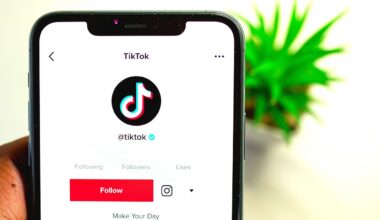Aspect Ratio Best Practices: Optimizing Your Social Media Images for Maximum Impact
When it comes to social media image optimization, understanding aspect ratios is crucial. Different platforms have unique dimensions that optimize image visibility and engagement. The aspect ratio, which is the relationship between the width and height of your image, plays a pivotal role in how your content is perceived. For instance, images that do not fit the recommended dimensions can appear cropped or distorted, hindering your brand’s message. It’s essential to optimize your images based on the specifications of each social media platform. Instagram, for example, favors a square aspect ratio of 1:1 for posts, while stories usually require a taller format like 9:16. These deviations affect how users interact with your content. If your images are not optimized correctly, you could lose potential followers and engagement. To create impactful posts, familiarize yourself with the specific requirements of each platform. Taking this small but significant step ensures your images are visually appealing, helping to capture attention and drive engagement. Therefore, devote time to understanding and applying these standards accurately as they form the foundational guidelines for effective social media image strategy.
To truly master aspect ratio best practices, it is essential to utilize tools and resources designed for proper image sizing. Many design platforms, such as Canva and Adobe Spark, offer templates tailored for specific social media networks. These templates simplify the process by automatically adhering to the correct dimensions. Therefore, employing these resources can save time and effort in image creation. Moreover, you can use online aspect ratio calculators to determine the right sizes for your images based on the platform you intend to use. This can be incredibly beneficial, especially for anyone new to the world of social media marketing. Additionally, consider leveraging analytics tools to monitor how images with various aspect ratios perform. This data-driven approach allows you to refine your strategy over time. Conducting A/B testing with different aspect ratios will grant you insight into what resonates best with your audience. The combinations of these efforts will lead to a better understanding of your audience’s preferences, ultimately improving your social media engagement rates. Consequently, being proactive about image optimization will help you communicate your brand message more effectively across platforms.
The Importance of Visual Consistency
Visual consistency is another vital aspect when dealing with social media images. Maintaining a uniform aspect ratio across your posts strengthens your brand identity. When followers consistently see such images, they develop a sense of familiarity and trust in your brand. This uniformity extends beyond just aspect ratio; it also involves color schemes, filters, and overall graphic styles. For instance, brands like Apple and Nike have established a distinctive visual style that their audiences immediately recognize. Adopting a consistent aspect ratio enhances not just brand awareness but also makes your feed more visually appealing. Fans are more likely to engage with a cohesive visual narrative than with a chaotic, mixed media stream. To maintain this, create a style guide that highlights the aspect ratios and styles you wish to use across platforms. Furthermore, as social media algorithms increasingly prioritize visually engaging content, having a consistent visual identity will elevate your chances of appearing in users’ feeds. Such a strategic approach fosters deeper connections between your brand and its audience, driving better engagement over time. Consequently, invest in creating visually consistent content for maximum impact.
Another best practice is to adjust images for high-resolution displays, which are becoming increasingly common. Many devices today boast high-resolution screens that showcase images with remarkable clarity. Thus, images that appear crisp and vibrant on lower-resolution displays may look blurry or pixelated on these advanced screens. To overcome this issue, always upload high-quality images and ensure they meet or exceed the recommended dimensions for your chosen social media platform. A good rule of thumb is to use images that are at least 1080 pixels wide for Instagram. Additionally, using formats like PNG or high-resolution JPEGs can help maintain image quality across various platforms. Moreover, saving images in RGB color mode rather than CMYK ensures accurate color representation on digital displays. Implementing such best practices not only enhances the visual experience for your audience but also elevates your brand perception. Therefore, make it a point to regularly review your image quality and resolutions, ensuring every post reflects the highest possible standards. This attention to detail will lead to improved interaction and audience retention, showcasing your professionalism in the digital landscape.
Mobile-First Considerations
As mobile usage continues to dominate social media consumption, aspect ratio optimization must consider this trend. Most social media platforms offer mobile apps, where a significant portion of the user base interacts with content. Research suggests that the majority of social media engagements occur on mobile devices, meaning your images must be mobile-friendly. For instance, taller images (like 4:5) tend to perform better on feeds, as they take advantage of the vertical scrolling format that mobile interfaces adopt. To maximize visibility on these platforms, tailor your images for mobile viewers by ensuring critical information remains in view, even on smaller screens. Moreover, each platform has specific guidelines for mobile, often differing from desktop versions. Thus, adjust images accordingly for both formats to maintain coherence across devices. Additionally, continually assess the performance of your mobile content regarding engagement metrics. User behavior can shift, reflecting changes in preferred formats or sizes, so it’s crucial to stay informed. Ultimately, prioritizing mobile optimization will enhance user experiences, leading to greater interaction rates and loyalty to your content across social media platforms.
Incorporating user-generated content (UGC) into your social media strategy can provide further opportunities for engaging visuals while adhering to aspect ratio best practices. UGC often varies in format, but when curated correctly, it can enrich your brand’s online persona significantly. While sharing this content, ensure that it aligns with your established aspect ratio for consistency. Platforms like Instagram encourage the sharing of UGC to foster community, as correctly formatted images highlight your customers’ experiences with your products. This also takes the pressure off your team to continually produce original content while showcasing authentic interactions from satisfied customers. Such practices enhance trust and engagement, as new and potential customers often find reviews and experiences more relatable than branded content. When curating this content, always seek permission and give credit to the original creators. This not only builds brand loyalty but encourages further UGC submissions. Therefore, integrating UGC effectively will strengthen your brand image while optimizing aspect ratios ensures your feed remains visually appealing. This medieval approach can ultimately enhance the authenticity of your social media presence.
Final Thoughts on Aspect Ratios
Ultimately, mastering aspect ratio best practices can propel your social media image strategy forward, significantly improving engagement levels. The importance of adhering to platform-specific dimensions cannot be overstated if you wish to capture and retain audience attention. Understanding how to optimize for each network, while maintaining visual consistency, ensures a professional look that resonates with followers. Invest time in crafting content that not only meets image specifications but also aligns with your brand’s visual identity. Moreover, don’t shy away from experimenting with various formats while continuously monitoring performance indicators. This data-driven approach allows you the flexibility to pivot when necessary, enhancing your content strategy. Additionally, leveraging UGC reinforces community ties while diversifying your visual assets. As you consistently work on these areas, remember that social media landscape continues to evolve. Keeping abreast of trends, updates, and best practices is essential for maintaining relevance. Thus, always adapt your image strategy for continual growth, allowing your brand to thrive in the dynamic world of social media. With this strategic focus, the potential for connecting with your audience is limitless.
Finally, it is important to regularly review and refresh your content library, ensuring that your visual assets remain relevant and appealing over time. Outdated images can detract from your brand perception and make your profile appear inactive or unprofessional. Implementing a routine schedule for reviewing images can lead to newfound inspiration and opportunities for rebranding or enhancing your social media presence. Explore trends in visual storytelling, as these evolve quickly within the digital landscape. For increased engagement, consider collaborating with influencers who can create images tailored specifically to your brand’s guidelines while appealing to their own audience. Partnering in this manner not only allows for creative freedom but can give fresh and unique perspectives that resonate well with followers. In addition, feature updated images regularly, whether they are new products, promotions, or customer-centric content, to stimulate interest in your social media channels. By investing time in both quality and variety, your brand continuously captivates your audience’s attention. This proactive approach to image optimization positions your brand for sustained success while creating an environment that encourages collaboration, inspiration, and community engagement in the online space.


